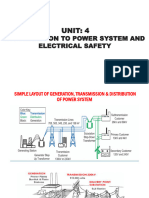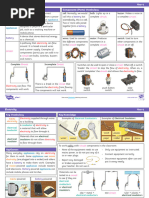Repairing Light Fixtures: Tools & Materials
Uploaded by
Thanh NguyenRepairing Light Fixtures: Tools & Materials
Uploaded by
Thanh NguyenRepairing Light Fixtures
L ight fixtures are attached permanently to
ceilings or walls. They include wall-hung
sconces, ceiling-hung globe fixtures, recessed
light fixtures, and chandeliers. Most light Electrical box
fixtures are easy to repair using basic tools and Metal braces
inexpensive parts.
If a light fixture fails, always make sure the light
bulb is screwed in tightly and is not burned out. A
Hot wire
faulty light bulb is the most common cause of light
fixture failure. If the light fixture is controlled by a
wall switch, also check the switch as a possible source Grounding wire
of problems.
Light fixtures can fail because the sockets or Neutral wire
built-in switches wear out. Some fixtures have sockets
and switches that can be removed for minor repairs. Mounting strap
These parts are held to the base of the fixture with
mounting screws or clips. Other fixtures have sockets Grounding screw
and switches that are joined permanently to the base.
If this type of fixture fails, purchase and install a new
light fixture.
Damage to light fixtures often occurs because
homeowners install light bulbs with wattage ratings
that are too high. Prevent overheating and light fixture Mounting
failures by using only light bulbs that match the screws
wattage ratings printed on the fixtures. Fixture base
Techniques for repairing fluorescent lights are
different from those for incandescent lights. Refer to
pages 288 to 293 to repair or replace a fluorescent
light fixture.
Tab
Brass screw terminal
Tools & Materials 쑺
Socket (cutaway)
Circuit tester Combination tool
Screwdriver Replacement parts,
Continuity tester as needed Shade
In a typical incandescent light fixture, a black hot wire is
connected to a brass screw terminal on the socket. Power flows
to a small tab at the bottom of the metal socket and through a
metal filament inside the bulb. The power heats the filament and
causes it to glow. The current then flows through the threaded
portion of the socket and through the white neutral wire back to
the main service panel.
278 ■ THE COMPLETE GUIDE TO WIRING
Before 1959, incandescent light fixtures
Electrical Wood (shown cutaway) often were mounted
box blocking
directly to an electrical box or to plaster
lath. Electrical codes now require that
fixtures be attached to mounting straps
that are anchored to the electrical boxes. If
you have a light fixture attached to plaster
Hot wire lath, install an approved electrical box with
a mounting strap to support the fixture.
Neutral wire
Screw terminals
Mounting screws
Problem Repair
Wall- or ceiling-mounted fixture flickers or does not light. 1. Check for faulty light bulb.
2. Check wall switch and repair or replace, if needed.
3. Check for loose wire connections in electrical box.
4. Test socket and replace, if needed (pages 280 to 281).
5. Replace light fixture.
Built-in switch on fixture does not work. 1. Check for faulty light bulb.
2. Check for loose wire connections on switch.
3. Replace switch.
4. Replace light fixture.
Chandelier flickers or does not light. 1. Check for faulty light bulb.
2. Check wall switch and repair or replace, if needed.
3. Check for loose wire connections in electrical box.
4. Test sockets and fixture wires, and replace, if needed.
Recessed fixture flickers or does not light. 1. Check for faulty light bulb.
2. Check wall switch and repair or replace, if needed.
3. Check for loose wire connections in electrical box.
4. Test fixture and replace, if needed.
Repair Projects ■ 279
■ How to Remove a Light Fixture & Test a Socket
1 2
Grounding
screw
Turn off the power to the light fixture at the main service Test for power by touching one probe of a circuit tester to
panel. Remove the light bulb and any shade or globe, then the green grounding screw, then inserting the other probe into
remove the mounting screws holding the fixture base to the each wire connector. Tester should not glow. If it does, there is
electrical box or mounting strap. Carefully pull the fixture base still power entering the box. Return to the service panel and
away from the box. turn off power to the correct circuit.
3 4
Metal tab
Disconnect the light fixture base by loosening the Adjust the metal tab at the bottom of the fixture socket by
screw terminals. If fixture has wire leads instead of screw prying it up slightly with a small screwdriver. This adjustment
terminals, remove the light fixture base by unscrewing the will improve the contact between the socket and the light bulb.
wire connectors.
5 Metal tab
6 Neutral screw
terminal
Hot screw Threaded
terminal portion of socket
Test the socket (shown cutaway) by attaching the clip of a Attach tester clip to neutral screw terminal (or white wire
continuity tester to the hot screw terminal (or black wire lead) lead), and touch probe to threaded portion of socket. Tester
and touching probe of tester to metal tab in bottom of socket. should glow. If not, socket is faulty and must be replaced. If
Tester should glow. If not, socket is faulty and must be replaced. socket is permanently attached, replace the fixture.
280 ■ THE COMPLETE GUIDE TO WIRING
■ How to Replace a Socket
1 2
Remove the old light fixture. Remove the socket from the Purchase an identical replacement socket. Connect the
fixture. The socket may be held by a screw, clip, or retaining white wire to the silver screw terminal on the socket, and
ring. Disconnect wires attached to the socket. connect the black wire to the brass screw terminal. Attach the
socket to the fixture base, and reinstall the fixture.
■ How to Test & Replace a Built-in Light Switch
1 Retaining ring 2
Switch
leads
Remove the light fixture. Unscrew the retaining ring holding Label the wires connected to the switch leads.
the switch. Disconnect the switch leads and remove the switch.
3 4
Test the switch by attaching the clip of the continuity tester If the switch is faulty, purchase and install an exact
to one of the switch leads and holding the tester probe to the duplicate switch. Remount the light fixture, and turn on the
other lead. Operate the switch control. If the switch is good, the power at the main service panel.
tester will glow when the switch is in one position, but not both.
Repair Projects ■ 281
Copyright of Complete Guide to Wiring is the property of Creative Publishing international, Inc. d/b/a Quayside
Publishing Group and its content may not be copied or emailed to multiple sites or posted to a listserv without
the copyright holder's express written permission. However, users may print, download, or email articles for
individual use.
You might also like
- Black&Decker. ADVANCED HOME WIRING Current With 2012-2015 Codes PDF100% (7)Black&Decker. ADVANCED HOME WIRING Current With 2012-2015 Codes PDF409 pages
- Black & Decker Wiring Repairs - Current With 2011-2013 Electrical Codes100% (1)Black & Decker Wiring Repairs - Current With 2011-2013 Electrical Codes127 pages
- SPTC - Instructional Materials - Eim NC IiNo ratings yetSPTC - Instructional Materials - Eim NC Ii11 pages
- Installing Wiring Devices For Floor and Wall Mounted Outlets, Lighting Fixtures, Switches and Auxiliary Outlets100% (1)Installing Wiring Devices For Floor and Wall Mounted Outlets, Lighting Fixtures, Switches and Auxiliary Outlets24 pages
- Study Notes - Electricity and Circuits - Science Class 6 PDF DownloadNo ratings yetStudy Notes - Electricity and Circuits - Science Class 6 PDF Download5 pages
- Chapter 3repairing The Electrical SystemNo ratings yetChapter 3repairing The Electrical System1 page
- 6 Common Wire Connection Problems and Their SolutionsNo ratings yet6 Common Wire Connection Problems and Their Solutions2 pages
- Unit-4 - Power System & Electrical Safety - 231214 - 195205No ratings yetUnit-4 - Power System & Electrical Safety - 231214 - 19520525 pages
- List of Experiments: Ge8261-Engineering Practices Laboratory - Group BNo ratings yetList of Experiments: Ge8261-Engineering Practices Laboratory - Group B57 pages
- Black & Decker Advanced Home Wi - Editors of Creative PublishingNo ratings yetBlack & Decker Advanced Home Wi - Editors of Creative Publishing727 pages
- Engineering Practice Lab Manual Electrical and ElectronicsNo ratings yetEngineering Practice Lab Manual Electrical and Electronics55 pages
- Engineering Practices Laboratory Manual Subject Code: Ge1X03No ratings yetEngineering Practices Laboratory Manual Subject Code: Ge1X0328 pages
- WEEK 5 - Electricity and Its Sources Building Utilities 2No ratings yetWEEK 5 - Electricity and Its Sources Building Utilities 230 pages
- What Causes Cables To Get Heated Up and Melt in A Circuit?No ratings yetWhat Causes Cables To Get Heated Up and Melt in A Circuit?6 pages
- Using Properly Tools and Equipment Ninstallation and MaintenanceNo ratings yetUsing Properly Tools and Equipment Ninstallation and Maintenance12 pages
- New Product Development - Mee1009: Digital Assignment-1No ratings yetNew Product Development - Mee1009: Digital Assignment-17 pages
- Knowledge Organiser - Electricity Year 4No ratings yetKnowledge Organiser - Electricity Year 42 pages
- MA-Tube Wall Light_Installation Instructions_2020No ratings yetMA-Tube Wall Light_Installation Instructions_202013 pages
- A Fish Tape Is Used To Pull Stranded or Solid Wire Through Metal or PVC ConduitNo ratings yetA Fish Tape Is Used To Pull Stranded or Solid Wire Through Metal or PVC Conduit23 pages
- Slide No. Slide Content Voice Over: ( (VIDEO:13018) ) + P.15.3.2No ratings yetSlide No. Slide Content Voice Over: ( (VIDEO:13018) ) + P.15.3.24 pages
- Understanding Electrical Grounding in Household WiringNo ratings yetUnderstanding Electrical Grounding in Household Wiring7 pages
- One Lamp Controlled by One Switch: 19EEE181Basic Electrical and Electronics Engineering LabNo ratings yetOne Lamp Controlled by One Switch: 19EEE181Basic Electrical and Electronics Engineering Lab8 pages
- Simply Fit Hybrid LED Tubes Please Read These Instructions Carefully Before Installation Leave A Copy For The User / Maintenance Engineer For Future ReferenceNo ratings yetSimply Fit Hybrid LED Tubes Please Read These Instructions Carefully Before Installation Leave A Copy For The User / Maintenance Engineer For Future Reference2 pages
- Engineering Practice Lab Manual (Electrical and Electronics)70% (10)Engineering Practice Lab Manual (Electrical and Electronics)55 pages
- Wiring Repairs Simplified for Beginners: Step by Step Guide on How to Do Common Wiring Repairs Around Your HomeFrom EverandWiring Repairs Simplified for Beginners: Step by Step Guide on How to Do Common Wiring Repairs Around Your HomeNo ratings yet
- EVERLINE LED Fixtures & Retrofit Kit: A Custom Presentation ForNo ratings yetEVERLINE LED Fixtures & Retrofit Kit: A Custom Presentation For16 pages
- Westinghouse Lighting Condensed Product Catalog 7-78No ratings yetWestinghouse Lighting Condensed Product Catalog 7-7852 pages
- "Lighting Audit": Urdaneta City University College of Engineering and Architecture S.Y. 2017No ratings yet"Lighting Audit": Urdaneta City University College of Engineering and Architecture S.Y. 20176 pages
- MDG Prijepolje Prizemlje Prostorije Var.1 Dizajn ArhitektaNo ratings yetMDG Prijepolje Prizemlje Prostorije Var.1 Dizajn Arhitekta27 pages
- Self Declaration Process For Household GoodsNo ratings yetSelf Declaration Process For Household Goods100 pages
- Wall-Mounted: Energy and Lamps InstallationNo ratings yetWall-Mounted: Energy and Lamps Installation3 pages
- Black&Decker. ADVANCED HOME WIRING Current With 2012-2015 Codes PDFBlack&Decker. ADVANCED HOME WIRING Current With 2012-2015 Codes PDF
- Black & Decker Wiring Repairs - Current With 2011-2013 Electrical CodesBlack & Decker Wiring Repairs - Current With 2011-2013 Electrical Codes
- Installing Wiring Devices For Floor and Wall Mounted Outlets, Lighting Fixtures, Switches and Auxiliary OutletsInstalling Wiring Devices For Floor and Wall Mounted Outlets, Lighting Fixtures, Switches and Auxiliary Outlets
- Study Notes - Electricity and Circuits - Science Class 6 PDF DownloadStudy Notes - Electricity and Circuits - Science Class 6 PDF Download
- 6 Common Wire Connection Problems and Their Solutions6 Common Wire Connection Problems and Their Solutions
- Unit-4 - Power System & Electrical Safety - 231214 - 195205Unit-4 - Power System & Electrical Safety - 231214 - 195205
- List of Experiments: Ge8261-Engineering Practices Laboratory - Group BList of Experiments: Ge8261-Engineering Practices Laboratory - Group B
- Black & Decker Advanced Home Wi - Editors of Creative PublishingBlack & Decker Advanced Home Wi - Editors of Creative Publishing
- Engineering Practice Lab Manual Electrical and ElectronicsEngineering Practice Lab Manual Electrical and Electronics
- Engineering Practices Laboratory Manual Subject Code: Ge1X03Engineering Practices Laboratory Manual Subject Code: Ge1X03
- WEEK 5 - Electricity and Its Sources Building Utilities 2WEEK 5 - Electricity and Its Sources Building Utilities 2
- What Causes Cables To Get Heated Up and Melt in A Circuit?What Causes Cables To Get Heated Up and Melt in A Circuit?
- Using Properly Tools and Equipment Ninstallation and MaintenanceUsing Properly Tools and Equipment Ninstallation and Maintenance
- New Product Development - Mee1009: Digital Assignment-1New Product Development - Mee1009: Digital Assignment-1
- A Fish Tape Is Used To Pull Stranded or Solid Wire Through Metal or PVC ConduitA Fish Tape Is Used To Pull Stranded or Solid Wire Through Metal or PVC Conduit
- Slide No. Slide Content Voice Over: ( (VIDEO:13018) ) + P.15.3.2Slide No. Slide Content Voice Over: ( (VIDEO:13018) ) + P.15.3.2
- Understanding Electrical Grounding in Household WiringUnderstanding Electrical Grounding in Household Wiring
- One Lamp Controlled by One Switch: 19EEE181Basic Electrical and Electronics Engineering LabOne Lamp Controlled by One Switch: 19EEE181Basic Electrical and Electronics Engineering Lab
- How to Wire a Doll's House for Electricity - An Illustrated GuideFrom EverandHow to Wire a Doll's House for Electricity - An Illustrated Guide
- Simply Fit Hybrid LED Tubes Please Read These Instructions Carefully Before Installation Leave A Copy For The User / Maintenance Engineer For Future ReferenceSimply Fit Hybrid LED Tubes Please Read These Instructions Carefully Before Installation Leave A Copy For The User / Maintenance Engineer For Future Reference
- Engineering Practice Lab Manual (Electrical and Electronics)Engineering Practice Lab Manual (Electrical and Electronics)
- Wiring Repairs Simplified for Beginners: Step by Step Guide on How to Do Common Wiring Repairs Around Your HomeFrom EverandWiring Repairs Simplified for Beginners: Step by Step Guide on How to Do Common Wiring Repairs Around Your Home
- EVERLINE LED Fixtures & Retrofit Kit: A Custom Presentation ForEVERLINE LED Fixtures & Retrofit Kit: A Custom Presentation For
- Westinghouse Lighting Condensed Product Catalog 7-78Westinghouse Lighting Condensed Product Catalog 7-78
- "Lighting Audit": Urdaneta City University College of Engineering and Architecture S.Y. 2017"Lighting Audit": Urdaneta City University College of Engineering and Architecture S.Y. 2017
- MDG Prijepolje Prizemlje Prostorije Var.1 Dizajn ArhitektaMDG Prijepolje Prizemlje Prostorije Var.1 Dizajn Arhitekta
























































































